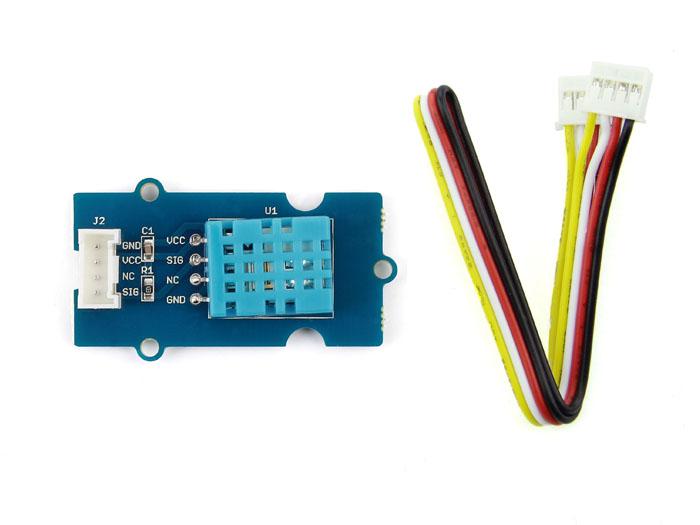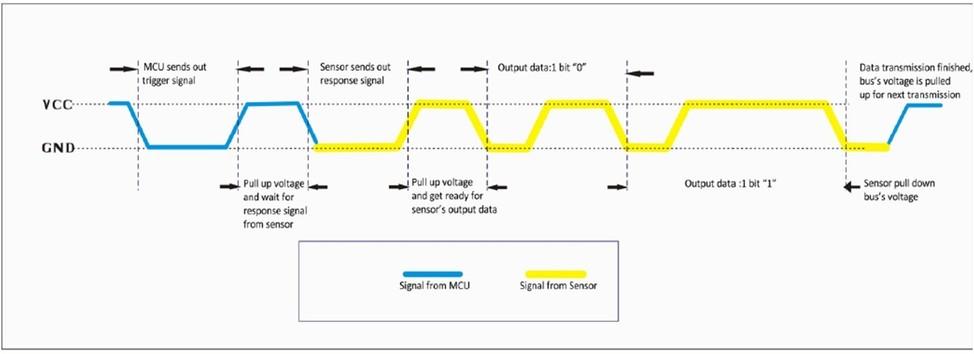Grove - Temperature&Humidity Sensor
Introduction

This temperature & humidity sensor provides a pre-calibrated digital output. A unique capacitive sensor element measures relative humidity and the temperature is measured by a negative temperature coefficient (NTC) thermistor. It has excellent reliability and long term stability. Please note that this sensor will not work for temperatures below 0 degree.
Features
- Relative Humidity and temperature measurement
- Full range temperature compensation Calibrated
- Digital signal
- Long term stability
- Long transmission distance(>20m)
- Low power consumption
Tip
More details about Grove modules please refer to Grove System
Applications Ideas
- Consumption product
- Weather station
- Humidity regulator
- Air conditioner
Hardware Overview

Specifications
Key Specifications
| Items | Min |
|---|---|
| PCB Size | 2.0cm*4.0cm |
| Interface | 2.0mm pitch pin header |
| IO Structure | SIG,VCC,GND,NC |
| ROHS | YES |
Electronic Characterstics
| Items | Conditions | Min | Norm | Max | Unit |
|---|---|---|---|---|---|
| VCC | - | 3.3 | - | 5 | Volts |
| Measuring Current Supply | - | 1.3 | - | 2.1 | mA |
| Average Current Supply | - | 0.5 | - | 1.1 | mA |
| Measuring Range | Humidity | 20% | - | 90% | RH |
| Temperature | 0 | - | 50 | °C | |
| Accuracy | Humidity | - | - | ±5% | RH |
| Temperature | ±2 | °C | |||
| Sensitivity | Humidity | - | 1% | RH | |
| Temperature | 1 | °C | |||
| Repeatability | Humidity | ±1% | RH | ||
| Temperature | ±1 | °C | |||
| Long-term Stability | ±1% | RH/year | |||
| Signal Collecting Period | 2 | S |
Usage
When MCU sends a trigger signal, sensor will change from low power consumption mode to active mode. After the trigger signal sensor will send a response signal back to MCU, then 40 bit collected data is sent out and a new signal collecting is trigged.(Note that the 40 bit collected data which is sent from sensor to MCU is already collected before the trigger signal comes.) One trigger signal receives one time 40 bit response data from sensor. Single-bus data is used for communication between MCU and sensor. The communication process is shown below:

It costs 5ms for single time communication.The high-order bit of data sends out first. Signal Data is 40 bit, comprised of 16 bit humidity data, 16 bit temperature data and 8 bit checksum.The data format is:
8bits integer part of humidity+8bits decimal part of humidity
+8bits integer part of temperature+8bits decimal part of temperature
+8bits checksum.
Programming
Connect the Temperature and Humidity sensor to analog port A0.Then you can use the following programme to gain the temperature and humidity of the environment.(The code is for seeeduino only,if you use seeeduino mega you should change the code a little. See below, if you use seeeduino mega, you should change PINC to PINF, change DDRC to DDRF and change PORTC to PORTF)

#define DHT11_PIN 0 // ADC0
byte read_dht11_dat()
{
byte i = 0;
byte result=0;
for(i=0; i< 8; i++){
while(!(PINC & _BV(DHT11_PIN))); // wait for 50us
delayMicroseconds(30);
if(PINC & _BV(DHT11_PIN))
result |=(1<<(7-i));
while((PINC & _BV(DHT11_PIN))); // wait '1' finish
}
return result;
}
void setup()
{
DDRC |= _BV(DHT11_PIN);
PORTC |= _BV(DHT11_PIN);
Serial.begin(9600);
Serial.println("Ready");
}
void loop()
{
byte dht11_dat[5];
byte dht11_in;
byte i;
// start condition
// 1. pull-down i/o pin from 18ms
PORTC &= ~_BV(DHT11_PIN);
delay(18);
PORTC |= _BV(DHT11_PIN);
delayMicroseconds(40);
DDRC &= ~_BV(DHT11_PIN);
delayMicroseconds(40);
dht11_in = PINC & _BV(DHT11_PIN);
if(dht11_in){
Serial.println("dht11 start condition 1 not met");
return;
}
delayMicroseconds(80);
dht11_in = PINC & _BV(DHT11_PIN);
if(!dht11_in){
Serial.println("dht11 start condition 2 not met");
return;
}
delayMicroseconds(80);
// now ready for data reception
for (i=0; i<5; i++)
dht11_dat[i] = read_dht11_dat();
DDRC |= _BV(DHT11_PIN);
PORTC |= _BV(DHT11_PIN);
byte dht11_check_sum = dht11_dat[0]+dht11_dat[1]+dht11_dat[2]+dht11_dat[3];
// check check_sum
if(dht11_dat[4]!= dht11_check_sum)
{
Serial.println("DHT11 checksum error");
}
Serial.print("Current humdity = ");
Serial.print(dht11_dat[0], DEC);
Serial.print(".");
Serial.print(dht11_dat[1], DEC);
Serial.print("% ");
Serial.print("temperature = ");
Serial.print(dht11_dat[2], DEC);
Serial.print(".");
Serial.print(dht11_dat[3], DEC);
Serial.println("C ");
delay(2000);
}
Resources
Help us make it better
Welcome to the new documentation system of Seeed Studio. We have made a lot of progress comparing to the old wiki system and will continue to improve it to make it more user friendly and helpful. The improvement can't be done without your kindly feedback. If you have any suggestions or findings, you are most welcome to submit the amended version as our contributor via Github or give us suggestions in the survey below, it would be more appreciated if you could leave your email so that we can reply to you. Happy Hacking!

